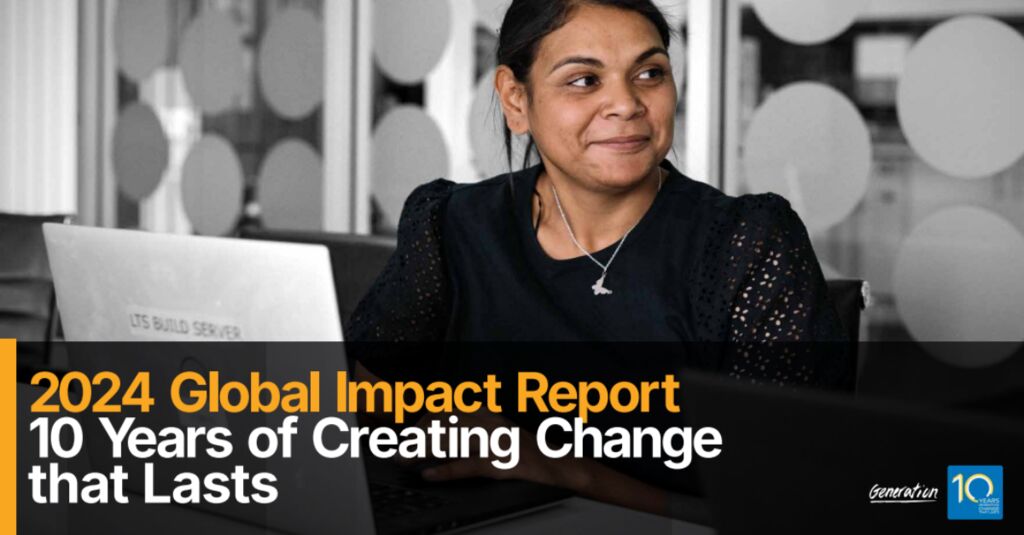The Multiplier Effect: How Generation’s Work Impacts Families and Communities

How Strategic Workforce Development Investment Creates Lasting Economic Mobility: The Philanthropic Case for Measurable Impact Learn why investing in workforce development creates lasting mobility—philanthropic strategies that deliver measurable, sustainable impact globally.
Read it now
“I was searching for work. There were four lives depending on my job.”
That’s how one Generation graduate describes the pressure and the hope that comes with a new career. After completing the program, she landed a job within a week. Her paycheck didn’t just change her life. It meant her children could stay in school, her family could afford better nutrition, and her father could finally get the medical care he needed.
This is the multiplier effect in action.
One person’s career success creates ripples that strengthen entire communities. For funders seeking measurable impact, Generation’s workforce development model offers something rare: positive impact on not just individuals, but the economic fabric of families and neighborhoods.
Strategic funders recognize this truth. They’re not only investing in job placement—they’re funding community transformation. With rapid labor market shifts brought forth by the latest advancements in AI and robotics, and global economic volatility, the need for proven, scalable solutions that create lasting change has never been greater.
Building Strong Foundations: How Career Success Transforms Households
Here’s a statistic that highlights the “why” of what we do: 28% of Generation graduates have dependents.
When these learners land careers earning 3-4 times their previous income, they’re not just changing their own lives. They’re rewriting the future for children, spouses, and extended family members who depend on them.
The math is simple and hopeful.
Before Generation, most learners earn survival wages—if they earn anything at all. 89% are unemployed, with nearly half facing long-term joblessness. Families stretch every dollar. Children go without. Healthcare is a luxury.
After graduation, everything shifts. The 3-4X increase in earnings that Generation graduates can achieve creates immediate family transformations:
- Nutrition improvement – Better food choices support family health and children’s development
- Healthcare access – Families afford preventive care instead of crisis-only medical attention
- Housing stability – Secure housing becomes achievable
- Education access – Children can stay in school and pursue higher education
Generation breaks intergenerational cycles that trap families in poverty. When a parent models career success, children absorb new possibilities. They witness the power of education and work.
These family transformations don’t happen in isolation; they compound. Across Generation’s 17 countries, communities feel the collective impact when their residents secure stable, well-paying careers. Employment becomes the foundation for broader community transformation.
Community Catalysts: The Ripple Effect of Local Economic Growth
This family-level transformation scales up dramatically. Generation’s graduates have earned $1.9+ billion in wages since 2015. But here’s what that figure means beyond their investments in their families: it is $1.9 billion circulating through local economies, supporting businesses, creating jobs, and strengthening communities.
When families gain stable income, they spend locally. Generation graduates shop at neighborhood stores, eat at community restaurants, and use local services.
Increased spending power creates measurable community transformations:
- Local business growth – Small businesses gain customers with real disposable income
- Economic diversification – New demand supports business expansion and job creation
- Housing market stability – Employed residents contribute to neighborhood stability
- Community investment – Higher local income supports community improvements
The transformation extends beyond economics. Employed graduates become community contributors and leaders. They participate in community organizations, support local initiatives, and mentor others pursuing career changes. Economic stability correlates directly with civic engagement across cultures.
These net positive initiatives create virtuous cycles. Stronger local economies attract additional businesses and investment. Improved communities retain talent while drawing new residents. Areas that once struggled with economic decline begin showing growth patterns.
The multiplier effect compounds over time.
A single graduate’s success encourages neighbors to pursue training. Local employers recognize the value of skilled workers and expand hiring. Entire regions can shift from economic stagnation to sustainable growth.
But how do we know these changes last? The data tells a remarkable story.
Measuring What Matters: Long-term Impact Assessment
Funders want to see a return on their investment. Generation delivers it through rigorous measurement spanning individual outcomes to community-wide transformation. The organization tracks data across the learner journey, creating one of the most comprehensive workforce development datasets globally, with more than 48 million data points collected across all programs and countries.
The Durability metrics—measures of employment, income, and well-being outcomes over time—tell a compelling story. Years after graduation, Generation alumni maintain employment and continue earning above living wage. This isn’t just job placement—it’s sustained economic mobility that creates lasting community change.
With an 83% employment rate within six months, Generation’s graduates significantly outperform industry standards, creating immediate and sustained returns. This impact aligns with World Bank research, which confirms that effective skills development programs reduce unemployment, increase productivity, and improve standards of living at the community level.
The model aligns with Sustainable Development Goal 8, which focuses on promoting decent work and economic growth.
Related to this topic:
How Strategic Workforce Development Investment Creates Lasting Economic Mobility: The Philanthropic Case for Measurable Impact
Scaling Impact: The Strategic Funder’s Perspective
Forward-thinking funders recognize that Generation’s model offers something rare: a replicable approach to community transformation through workforce development. The organization’s presence in 17 countries proves the model’s adaptability across diverse economic and cultural contexts.
Replicability stems from our systematic methodology and approach. Generation’s seven-component methodology creates consistent outcomes across all locations:
- Direct employer engagement
- Mentorship and alumni community support
- Measurable ROI tracking for all stakeholders
- Data collection across the entire learner journey
- Connections with employers for rapid job placement
- Learner recruitment based on potential, not just credentials
- Comprehensive, profession-specific training (technical + behavioral + mindset skills) and social supports
This represents system-level change. Generation moves beyond temporary assistance to an economic development strategy. Communities gain sustainable capacity to address unemployment while meeting employer needs for skilled workers. The model creates lasting infrastructure for economic mobility.
The future vision is clear: resilient communities built through workforce development. As automation and economic trends impact the workplace, communities need adaptive capacity to retrain workers and attract new industries. Generation’s model provides this foundation.
For funders committed to net positive impact and corporate social responsibility, Generation offers measurable returns on social investment. Our organization’s systematic approach enables funders to track progress, demonstrate concrete impact, and refine strategies for maximum effectiveness.
The multiplier effect creates lasting change.
When funders invest in Generation, they’re not just changing individual lives. They’re transforming families, strengthening communities, and building economic resilience that can last for generations.



